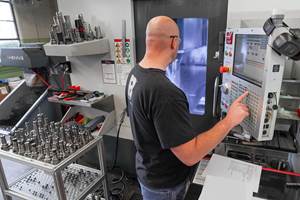A Brief Update On CAM Software Automation
A continuing objective for CAM software suppliers is to enhance the ease of use and level of automation, even as additional functionality is being introduced. As such, the evolutionary march toward further automation of the NC programming function continues.
Share






A continuing objective for CAM software suppliers is to enhance the ease of use and level of automation, even as additional functionality is being introduced. As such, the evolutionary march toward further automation of the NC programming function continues. Many users state that they prefer total push-button automation, while others favor retaining control of the process and some degree of flexibility. In a recent study of worldwide moldmakers conducted by CIMdata, the extent of desired automation was ascertained. The results are shown in the following table:
It can be seen that more than 90 percent of the users prefer a significant level of automation. Further, the most frequent responses were from those who favor maximum automation and those who desire automation, but with guidance being left to the user. Maximum automation can currently be obtained by extensive software customization by users. Firms producing a parametric family of products, such as golf clubs, bottles or shoes, often employ this technique. In addition, research projects are underway, such as the one being conducted by STEP Tools, to directly cut a part from a CAD model without employing an NC programming process as an intermediary operation. When successful, this approach will provide a high degree of CAM programming automation.
ÌýÌýTable 1: Degree of automation preferred | |
| Provide guidance to a user/not full automation | 38.9% |
| Obtain maximum automation | 37.0% |
| Automate standard functions only | 14.9% |
| Retain maximum user flexibility/limited automation | 9.3% |
Concurrently, to further software automation, a number of vendors have implemented or are implementing knowledge-based machining (KBM) software systems. Generally speaking, KBM systems are either adaptive or generative and are either feature-based or parts-based. In adaptive machining, traditional programming processes are captured by the software as programming occurs and are saved as process templates. In subsequent identical or similar situations, a template can be re-used directly or modified somewhat to adapt to a new situation. In generative machining, a predefined set of machining practices and/or rules are applied to a feature or a part. Given the part geometry, part material and tolerance, a machining process can automatically be created by the software.
In feature-based machining, a part is viewed as a group of interrelated manufacturing features such as pockets, holes or slots. Feature recognition is often used to automatically recognize the features. Specific machining strategies and parameters are then applied to each feature. This type of machining is usually employed for prismatically shaped parts. In parts-based machining, a part is treated as a whole with methodologies that address an entire part and the resultant areas that require rework. This technique is most appropriate for complex-shaped parts such as molds and dies. The following table illustrates this KBM concept and lists some example vendors and products that employ the technique.
Table 2. Knowledge-based machining grid | ||
| Ìý | Adaptive | Generative |
| Feature-based | PTC/Expert Machinist | EGS/FeatureCAM |
| Parts-based | UGS/UG CAM | Delcam/PowerMILL |
Over time there has been an evolution or cycling in the KBM technology being introduced by suppliers. The first products introduced in the late 1980s and early 1990s were generative-based products. These systems did not become commercially successful, primarily because of the level of effort required by users to embed their machining practices and rules in the process. In the mid to late 1990s, the adaptive approach became commonplace, as it requires a minimum front-end investment.
In comparing adaptive and generative KBM software, each approach has its advantages. The adaptive type is quicker to implement, does not require the creation of rules, involves lower development and maintenance costs, captures settings and does not base efficiency on the number of rules. The generative type is likely to be the ultimate solution, is more flexible to design changes and the range of parts, captures manufacturing rationale, has a process independent of templates and does not create a file management problem.
Related Content
Lean Approach to Automated Machine Tending Delivers Quicker Paths to Success
Almost any shop can automate at least some of its production, even in low-volume, high-mix applications. The key to getting started is finding the simplest solutions that fit your requirements. It helps to work with an automation partner that understands your needs.
Read MoreMedical Shop Performs Lights-Out Production in Five-Axes
Moving to five-axis machining enabled this shop to dramatically reduce setup time and increase lights-out capacity, but success relied on the right combination of workholding and automation.
Read MoreUsing Jaws as Grippers Enables Flexible, Low-Cost Automation
VersaBuilt’s automation systems significantly boosted Innovative Fabrication’s revenue. In return, the shop has helped VersaBuilt optimize its products.
Read MoreIncreasing Productivity with Digitalization and AI
Job shops are implementing automation and digitalization into workflows to eliminate set up time and increase repeatability in production.
Read MoreRead Next
AMRs Are Moving Into Manufacturing: 4 Considerations for Implementation
AMRs can provide a flexible, easy-to-use automation platform so long as manufacturers choose a suitable task and prepare their facilities.
Read MoreMachine Shop MBA
Making Chips and Modern Machine Shop are teaming up for a new podcast series called Machine Shop MBA—designed to help manufacturers measure their success against the industry’s best. Through the lens of the Top Shops benchmarking program, the series explores the KPIs that set high-performing shops apart, from machine utilization and first-pass yield to employee engagement and revenue per employee.
Read More
















